His name is Dominique Robert. He spent two months of his summer vacation at the Club for a long time when he was a teenager, in the 60s and 70s, whether as a Sailing GO (at 15, he was the Club's youngest Sailing GO) or as a Sound GO.
Recently, he returned to the abandoned village of Caprera in Sardinia, closed since 2007, in order to photographically document the place, in "urbex" mode, before everything disappears, since this is, most certainly, the intention of the Natural Park within the perimeter of which the village is included. It is only a question of money, but it will undoubtedly happen as soon as the financial means have been found.
Following this moving return to a village he knew so well almost fifty years ago, he wrote a two-part story, largely illustrated with photographs of the place.
Here is the first part of his report.
Enjoy reading.
Some photos in this report can be viewed in larger format. To do so, simply click on the image and a pop-up will open!
Fifty years later, what remains?
The village of Caprera (Sardinia)
Created in the late fifties on the concept that made the Club so successful in its early days (a dream location, a package that included everything at will, from sports to food and drink – except for drinks at the bar – with, to maintain profitability, minimal hotel services), Caprera had been operating for about fifteen years when I spent my first summer there. I was 12 years old, and my mother had seemed very worried when she showed me, in a French newspaper obtained who knows how (because that was also the miracle of the Club, at that time, to make you exist and have fun completely outside of place and time), an article relating the invasion of Czechoslovakia by the Russian army.
This means that the Club's "heroic era" was over, and that it was entering a phase of "first maturity." This did not prevent one from meeting village leaders such as Avner Gruszow (Cefalù, 1966 or 67), a Zionist activist affiliated twenty years earlier with the "Stern gang" and having committed a number of anti-English attacks in what would become the State of Israel, who had even been sent to London in 1948 to assassinate the Minister of Foreign Affairs (and had narrowly missed), who had recounted it all in A Time to Kill, A Time to Build but who, despite this troubled past, had managed to gain the trust of Father Trigano who entrusted him with villages, GO teams and thousands of GMs without the slightest ulterior motive. And since he was not often wrong, history, here too, proved him right. A certain Shalom Hassan, who was to become one of the great figures of the Club, was its head of sports in Cefalù.
In the summer of '68, in Caprera, Shalom had become village chief, his wife Maya head hostess, and the gentle bearded giant Czopp (pronounced "Tchopp"), head of sports and volleyball specialist on the clay courts installed at the nerve center of the village, under the pine forest, between the bar and the restaurant, where one could not fail to stop to admire the sporting feat, whether coming up from the beach or leaving the hut to go to dinner, having washed up. The bar necklaces (much more festive than the "bar notebooks" of the winter villages, with their mediocre paper tickets) only had three kinds of balls: white, café au lait and black, the most expensive. The gold ones would only be created later, with the help of inflation.
It was also that summer that, as I wrote in My Summers at the Club, a story published a few years ago on macase.net, I took on for the first time the responsibilities of a "quasi-GO Voile", even if they only consisted, at first, of taking registrations from GMs and forming balanced crews for the 420s, 445s and other 485s that we brought up after each regatta on the strap cradles installed on the narrow cement quay, almost at the foot of the first boxes. It wasn't much, even if I was very young to do it, it relieved the "real" GO Voile, and I was as proud as a bar-tabac!
It was by chance that I learned, at the beginning of 2015, that is to say almost half a century after my first stay, that Caprera was no longer being operated, which did not surprise me, the hotel orientation taken by the Club being hardly compatible with the relative austerity of the huts, none of which, let us remember, were even designed to lock: you had to remember to bring your own pitons (with the auger to drive them in) and your own padlock if you wished... What surprised me more was that, although a natural park had been created encompassing the island of Caprera, the authorities had left the village abandoned as it was, due to a lack of financial means to destroy it, and legal means to force the Club to do so, its long-term lease having expired in the meantime. In short, between the inertia of the local public authorities (the Italian islands are very regionalized) and the distance from Rome, the village was slowly sinking into oblivion, rotting on its feet, until the day when, perhaps, a helping hand would come to put an end to this long and silent agony, and wipe it off the map forever.
It was then that in a few minutes, in the depths of my long, foggy and cold winter evening, near Lyon, a conviction took root in me which, suddenly, became obvious: before the village of Caprera disappeared or was too disfigured by the passage of time, I had to return to the place to photographically document what remained of this part of my past, of those weeks so rich and wonderful that I had spent there, so formative also for me who was then on the threshold of adolescence. More than ten years later, as I wrote in My Summers, I had returned there, and there too memories had accumulated, which a return to the place would allow to be exorcised.
Preparing for a trip, as everyone knows, is already traveling, and thanks to the internet, preparation today can be easily in-depth and detailed. Before leaving, I had therefore closely studied the satellite photos on Google Earth, as well as those published by Internet users who had visited the village before its closure, or who had been in the area since. Thanks to these images, as well as a few contacts I was able to make by email, I acquired the only certainty that mattered to me: it should not be difficult to physically access the village grounds. For example, from the beach, only a flimsy plastic barrier barely more than a meter high protected access. If necessary, I took my trusty Leatherman with me, which I would know how to use, in the worst case scenario, to commit the violation of private property that I was quite ready to assume in the interest of photographic documentation and the duty of remembrance! I didn't think I was more right... but let's not get ahead of myself.
So I arrived in Sardinia, and more precisely in La Maddalena, on a perfectly ordinary weekday evening (and chosen as such) at the end of April 2015. Too early in the season for the first holidaymakers to be there already to be interested in my activities, but still late enough to be almost guaranteed typical Sardinian weather: sun, beautiful light, not too hot. You bet! When I landed in Alghero, it was rain that greeted me, even though I had just left Lyon where it was sunny!
Breton landscapers know this well: there is nothing like alternating showers (even if they are a bit prolonged) and clear spells to create beautiful light, and that evening, on the ferry that was taking me from Palau to La Maddalena, I took advantage of the opportunity.
 Grainy skies over the Strait of Bonifacio
Grainy skies over the Strait of Bonifacio
 Chaotic sky above La Maddalena
Chaotic sky above La Maddalena
The next morning, the rain was still falling, persistent, stubborn. Judging by the look of things, it had fallen all night, and I wondered if the dirt track that led to the Club's small beach, Cala Garibaldi, and which was now open to everyone (in Italy, the car is king), had not been transformed into a quagmire. To deal with this kind of eventuality, I had tried to rent a 4x4, but it was a waste of time; I had only obtained one of those very fashionable "cross-overs" which are nothing more than slightly raised everyday sedans. In any case, by late morning, the rain seemed to lessen in intensity, or even, at times, to stop completely. So I set off.
Caprera and La Maddalena, two islands that almost touch, have always been connected by a bridge. The very old, very narrow, and very rusty one that I had known was recently replaced by a modern, curved structure, somewhat in the flattering style of Calatrava. I passed by without stopping; my memories awaited me further on.
By dint of wearing out my eyes on Google Earth, I had memorized exactly the route to follow to arrive in front of what had been the "gate" of the village (a few rare GM, especially Italians, came there by car), before joining the sandy track of Cala Garibaldi. Soon, I arrived in front of a low wall and a small closed gate. The hut that must have housed the guardian/caretaker was dying silently, a tattered Italian flag flapped in the wind. It was very gray, at times the rain started again.
 The closed gate of the abandoned village...
The closed gate of the abandoned village...
 Through the foliage, the caretaker's hut and a tattered Italian pennant
Through the foliage, the caretaker's hut and a tattered Italian pennant
I waited a while for the rain to stop, devouring a salami sandwich I'd made that morning at the buffet of my colazione, then decided to take a closer look. The low wall was ridiculously easy to climb, in fact it was little more than a matter of stepping over it, and approaching the village "from behind" could contribute to greater discretion. The car was parked sheltered by vegetation, out of sight of the road. Of course, if you came right up to the gate, you couldn't miss it, but any other walker could have left it there without actually entering the old Club village... A prominently displayed sign proclaimed that the place was videosorvegliato, I carefully inspected the surroundings for a camera and found none: it was a show, and it would take more than that to dissuade me. I "made the wall" without difficulty; I was there.
What surprised me most at first was the vegetation. Except under the pine forest where I knew that not much grew through the thick carpet of pine needles, I had expected to have to face, here and there, a veritable jungle: in seven years of abandonment, it grows strangely, the garden knows something about that every spring! But here, the grass remained perfectly manageable, almost disciplined. I put this down to the summer droughts, which must quickly ruin the growth efforts initiated in the spring. The other surprising thing was the widespread greenness: I suddenly realized that I had only ever known Caprera in the height of summer, when the gardeners spared no effort (and the drinking water brought from Sardinia by tanker to the small cement jetty that demarcated the Club grounds) to keep a few square meters of lawn and flowers alive at the restaurant or around the bar; everywhere else it was a uniform yellow. And here, of course, at the beginning of spring, it was all green, new vegetation growing hopefully on the rotten remains of that of years past.
I began to walk slowly among the huts, in a necropolis-like silence, barely disturbed by the rare song of a bird. Someone had told me to be wary of wild boars, and besides, you may have noticed the very official sign announcing their presence in the first photo of this story—where it is specified that they should not be fed, which suggests a priori that they are quite friendly… Nevertheless, I know that these animals can be ferocious, especially when they have young (which was certainly the case at this time of year), so I kept an eye on the ground, and several times I went to spot leftovers, without seeing so much as a boar's tail. And apart from me, of course, not a soul was around.
The huts themselves were very similar to those I had known and lived in. I don't know how long the material they are made of lasts, but most of them were still in very good condition, and apparently very sound, with the exception of some roofs somewhat disheveled by the winds, always violent around the Strait of Bonifacio. Most of the nameplates were more recent than "mine," but I found with emotion some whose graphics were undoubtedly those used in the past. Who knows, moreover, some of these huts were perhaps exactly those I had known fifty years ago, their straw walls, apparently fragile, still holding up perfectly despite the accumulated winters?
 A “recent” box plate, with italic letters
A “recent” box plate, with italic letters
 “Old” case: its plaque, once blue, has lost its color and its letters are straight
“Old” case: its plaque, once blue, has lost its color and its letters are straight
The changes, however, were numerous, and striking for an "old-timer" like me. As soon as I entered the front door, the first shock: while "my" huts only had a sliding brass latch, or even, sometimes, a simple nickel-plated hook threaded into a curved eyebolt, lo and behold, all these "modern" huts were equipped with a solid latch intended to be padlocked... and besides, most of them were! Fortunately, some were open, saving me from having to break in... and then, the second shock: on the floor, there was no question of a simple cement screed (or even, as I had known, beaten earth!), but a nice, well-made tiled floor, whose durability I can testify to, even after seven years of abandonment!
 Almost all the boxes are thus closed with a padlock.
Almost all the boxes are thus closed with a padlock.
 The interior of a hut abandoned for eight years: dirty, but perfectly dry. A luxury wardrobe (!) with a strong cassette.
The interior of a hut abandoned for eight years: dirty, but perfectly dry. A luxury wardrobe (!) with a strong cassette.
Looking up, I noticed that the furniture, too, had changed a lot: certainly, the beds remained what they had always been, that is to say, basic, but there were now two wardrobes per hut (whereas before, only vile hoarders—or those with connections—displayed such luxury), and what's more, each of them was officially equipped with a safe, also ready to be padlocked, and in which the Club very officially recommended not leaving more than 250 euros in cash, and 2500 in jewelry and various valuables...! I was flabbergasted. Had there been a need for money at the Club? Didn't everything, as before, get deposited in the village safe upon arrival? Were those great social class levelers, the collar bar and the fear of theft (human nature remains what it is, alas! even at the Club) no longer there to help create the wonderful atmosphere we had known and so appreciated? Could one now leave one's Cartier watch in the "safe" of one's hut to proudly display it for others to covet in the evening at the bar, hoping to compensate for mediocre performances at archery, water polo or pétanque earlier in the day? Had the Club changed so much?
It seemed so: in each box, we thought we had to display a laminated map of the village (I kept one as a souvenir, it had fallen on the ground), whereas before, we managed very well without it (when we didn't know, we asked, it created bonds!). The odious precautionary principle, which infantilizes us and makes us all irresponsible, had struck there too, and besides, hadn't we gone so far as to equip each box with an electric ceiling light? Why not a jacuzzi and an iPhone dock, while we were at it?
 The village map, in case you get lost...
The village map, in case you get lost...
I left this first hut, perplexed. What I had seen there told me a lot about the way in which the Club, its spirit, its atmosphere, had evolved. All these new developments were undoubtedly going in the direction of a certain "progress". One could not deny the interest of electric light, which saved the most far-sighted from having to carry the famous blue Camping-Gaz lamp, very effective, attracting few critters (moreover, any GM who was a bit equipped also arrived with his six strips of mosquito netting pre-cut to the right dimensions, his small hammer and his nails, to protect the openings of his hut in case it had not already been done), but it is undeniable that lighting with a naked flame, even very protected, and giving off heat, was not ideal in a hut which was by nature highly combustible (including the roof!), itself located in the middle of others of its own and in an environment which was also very sensitive to fire.
 Strange “family” hut, the only one in the village
Strange “family” hut, the only one in the village
 Entrance “vestibule” to the family hut: one hut on the right, one on the left
Entrance “vestibule” to the family hut: one hut on the right, one on the left
Continuing my path, exploring from right to left, I came across a first "sanitary block", as we called, at the time, these common blocks bringing together sinks, showers, toilets, laundry tubs, in short the only water points (always drinkable, even if it sometimes didn't taste very good) in the village outside the restaurant, the bar and the activity areas. While, in the huts, bed bases, mattresses and wardrobes had been gathered in the center of the hut (to not facilitate the nesting of critters?), but left there, in the sanitary blocks everything that could reasonably be dismantled had been taken: taps, plugholes, pipes, siphons, everything was gone, without apparent vandalism, without brutality, without damage, as if the dismantling had been deliberately carried out calmly and methodically after closing time. However, the pipes must all have been PVC, and the taps chrome alloy, no copper in all that, but perhaps it still had a value that I was unaware of, and that the Club had wanted to realize before leaving the premises...
This first contact with "hard" walls was an opportunity to confirm, as I had thought I had seen before my departure in other photos, that everything I had known painted in a sober, Mediterranean white had since been covered with a kind of rather unpleasant egg yolk, which had aged badly. The village chief's hut, which I had had the honor of entering a few times, had undergone the same indigestible whitewashing, which was coming off in whole patches, revealing the white underneath, apparently of a much better quality.
At that moment I entered the pine forest, and perplexity assailed me again: there were no huts under the pine forest! They spread out to the side, in tiers as I remembered, right up to behind the bar and over the whole little promontory behind the sailing hut, but under the pine forest itself, nothing! The perspective was very beautiful, but it did not correspond at all to my memory.
 Perspective under the pine forest
Perspective under the pine forest
So, either the huts previously planted under the pine forest had been removed (probably for fire safety reasons), or the pine forest had once extended into all or part of the southern area of the village, between the offices and the parking lot, to simplify, and for some reason no longer existed, and had been replaced by various species. Perhaps a GM who reads this story will be able to provide me with the explanation of this mystery...
Not far from the village chief's hut (but closer than I remembered), I found the building of what used to be called the "Offices": Management, Cashier, Traffic, Planning, etc.
 A special box, next to the desks...
A special box, next to the desks...
What was it for? For the hostesses?
As I approached, I had a moment of emotion when I found, in exactly the same place, the small stone table and the four small square seats surrounding it, where I had so often sat to write. Apart from the yellowish whitewash, it hadn't changed at all; for a moment, I had just taken a leap back in time of more than two times Twenty Years Later in Reverse, which sent me back with incredible acuity to my memories as a young adolescent: the smell was the same, the objects were the same, right down to the cracked mosaic shards, and even the tree trunks didn't seem to have changed, even though they must have aged, just like me, half a century in the meantime!
Exactly as I remember... nothing has changed in fifty years (except the color)
Perhaps a maritime pine rounds out less quickly around the waist than a so-called homo sapiens?
After this emotional and temporal shock, I toured the Offices. Unlike the huts that had seemed to me, all things considered, to be in very good condition, still healthy and very dry despite the rain that had fallen since the day before, the permanent buildings of the Offices surprised me with their advanced dilapidation. Some of them were also protected by barrier tape and Danger of Collapse had been posted everywhere. And everywhere, doors and windows were carefully closed. As an urban explorer who respected his code of ethics, I did not break in and decided that the secrets that could be hidden behind these doors would remain inviolate.
 A very incongruous payphone
A very incongruous payphone
in this silent solitude
Continuing my peaceful walk under the pine forest, and now completely oblivious to these wild boars which had worried me a little at first, and which I knew preferred thick undergrowth to open ground, I headed towards another mysterious place in the village, where I had only been admitted once, and which I was preparing with delight to have all to myself: the Matériel.
I don't know what it is like in villages today, but in the villages of huts of the last century, there were always things to repair, small DIY jobs to do, a part to replace on a diving compressor, glass wool to repair the hull of a dinghy that another had badly dented, etc. You could find all this, and much more, in this Ali Baba's cave that was the Equipment. They had everything (or pretended to), and knew how to do everything (ditto): tools, materials, raw materials, sophisticated mechanical and electrical installations, carpentry, plumbing, plastering, all the trades that the village could need to function were represented there.
Of course, GMs were not allowed there, and even GOs only approached them with a sort of respect that they tried to hide behind a boastful air.
I entered it myself cautiously, not out of respect for tradition, but because I thought that if there was still a guardian in the village, that was where he would be. And from a Sardinian guardian, neurasthenic and disoccupato, one could expect anything. As much as I had not believed in the fable of video surveillance, the concept of the old Sardinian, invested with a quasi-mystical mission of guardian of this abandoned temple, and moreover a hunter like all old Sardinians (and therefore, equipped with a rifle), remained present in my mind.
This was not to be, however, and the Matériel turned out to be just as deserted as the rest of the village. These places, admittedly quite dirty, and moreover today devoid, with the exception of an old rusty industrial washing machine, of all those mysterious machines, pots and bags, and other complex tools (to my adolescent eyes, at least) that had built its myth, rather disappointed me. I only noted the presence of two small scooters and an electric golf cart, all rusty and dilapidated beyond all hope.
 Equipment access from outside the village.
Equipment access from outside the village.
Note the reference to "members with wristbands": so we were chipped at the Club in recent years?
 Interior of one of these dwellings
Interior of one of these dwellings
 More than the girl's buttocks, what's interesting here
More than the girl's buttocks, what's interesting here
is this collection of badges that the GOs probably wore.
Continuing my descent towards the sea, which I had now seen sparkling for a while between the pines, I reached the restaurant.
 Let's continue the descent towards the sea, which we can see beyond the pine trees...
Let's continue the descent towards the sea, which we can see beyond the pine trees...
 The restaurant: in the past, this space was filled with tables and benches
The restaurant: in the past, this space was filled with tables and benches
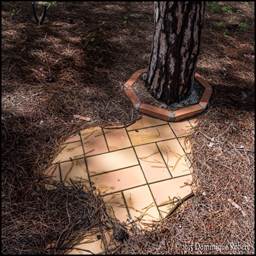 Original paving of the restaurant
Original paving of the restaurant
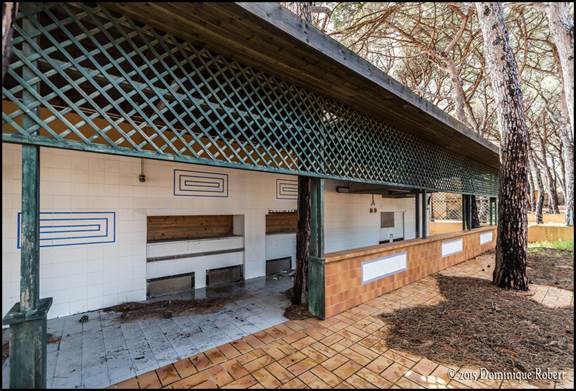 The kitchens, restaurant side: behind these counters were the grills, the barbecues.
The kitchens, restaurant side: behind these counters were the grills, the barbecues.
How small it seemed to me, devoid of its tables and benches, when it had seemed so vast when I had to walk through it among the hundreds of diners! How silent it was, sad, extinguished, to say the least, when I had known it to be so lively, buzzing, full of scents and flavors...! Yet it had hardly changed: under the thick carpet of pine needles, I could see the flagstone floor that I recognized, the very one I had often walked on barefoot, and in a corner, I found the moving fragments of a broken dish and plate, abandoned for years, and whose colors, too, spoke to me beyond the decades that had passed... How many memories, long buried, but suddenly revived by the contemplation of a few poor fragments of cheap porcelain!
I stood there, arms dangling, unable to tear myself away from this poor treasure, wondering whether I should first go to the bar, or rather to the nearby beach, which I could now clearly see was no longer blocked by the orange fence, all traces of which had disappeared... If I had known, I would have come straight that way...
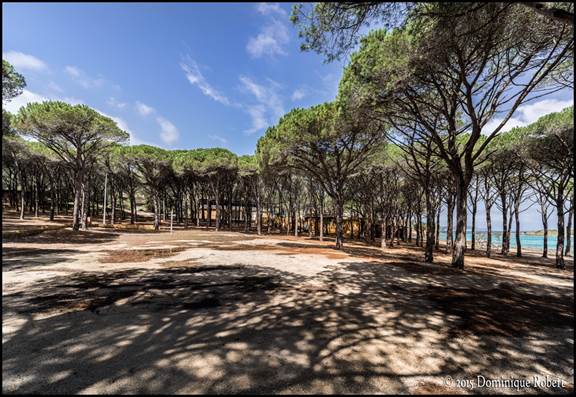 The old volleyball courts, in the background the bar and the dance floor, and to the right the sea, without any barriers...
The old volleyball courts, in the background the bar and the dance floor, and to the right the sea, without any barriers...
I was at this point in my reflections when I saw a small black Fiat appear from the depths of the village, driving at a good speed, obviously in the hands of someone who knew the area. I thought at first that it was a local visiting, and wondered how he could have gone to avoid the bad track of Cala Garibaldi. Then, when he got out of his car, making big expressive waves with his arms, and I could read the inscription "VIGILPOL" on his black shirt, I realized that I had just been caught with my hand in the jam jar.
We were going to have to negotiate... the Italian way.
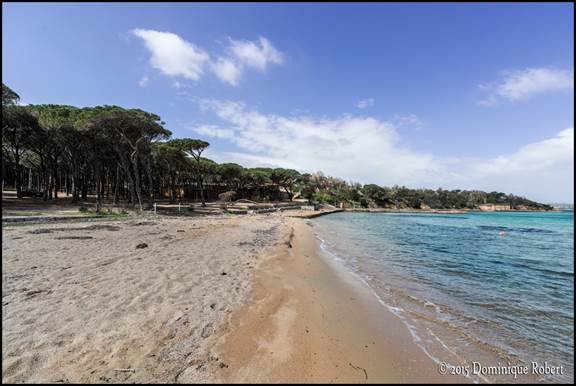 Cala Garibaldi beach. If you look closely,
Cala Garibaldi beach. If you look closely,
the security guard's car on the left, under the pine trees
END OF PART ONE























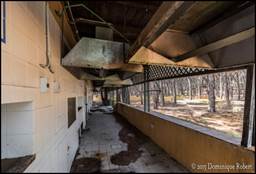

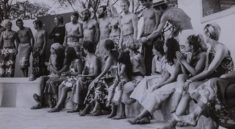
Hello; I knew the club in 1982… so many good memories during these almost 2 months. The atmosphere was superb and in the evening the bar brought us together, some mornings headache… lagrappa had been there. We danced a lot and participated in the different shows, always well guided by the GOs..
🎶💕🎶👏👏👏
The boxes suited us and the GOs were great.
Too bad everything is going a bit to the dogs.
La Maddalena very welcoming, I appreciated this hospitality.
Good luck in your various actions and I am not the only one to feel a little nostalgia.
Yours, nina (Breton) 👏👏👏
Hello, I was a GO lighting engineer intern for 3 months in the 80s/82s, I don't remember too much, there was a great atmosphere, the village chief was Machepro, a well-developed and very friendly lady.
I continued for 2 more seasons in Wenguen in the mountains to finish at the restanques near St Tropez, so many good memories....